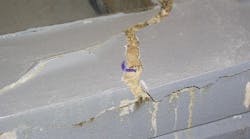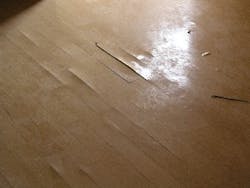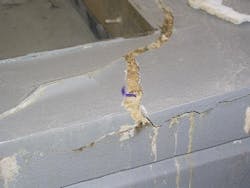A Colorado facility recently faced a flooring dilemma that is becoming increasingly common around the country. The situation: Moisture content of precisely a new concrete slab met the flooring manufacturer’s recommendations. However, the concrete showed a high pH of 10 to 11. The result: The manufacturer wouldn’t warranty the finish flooring and construction ground to a halt.
A high-tech corporate and manufacturing facility in Austin, Texas struggled for 15 years with floor-tile failures due to moisture and high pH. It spent more than $250,000 to remove its failed floor tile and encapsulate the concrete slab with a moisture barrier to install a warrantable floor covering that will provide 2,000-psi strength for the massive machinery that moves across this floor (Figure 1).
Figure 1. Moisture and pH problems led to strip failure, stressed vinyl composition tile and efflorescence in the seams.
Behind the moisture-pH dilemma
Balancing the right pH and the right moisture level in slabs can be a challenging and often costly problem. Concrete has a naturally high pH. But, many flooring manufacturers won’t warranty installations if the pH is at those naturally high levels, even though moisture is low (Figure 2). Nationwide, moisture and pH-related flooring problems have reached the billion-dollar level annually, according to independent concrete flooring expert Scott M. Tarr, principal engineer at CTL Group, Skokie, Ill. Some factors driving these problems include:
Figure 2. Coatings failure and pH irregularity caused cracks in this floor.
- Eliminating asbestos in resilient flooring
- Banning solvents from adhesive and coating systems. In 1995, federal law banned the use of petroleum-based adhesives. New flooring glues are more sensitive to alkali environments, and eventually fail when pH is too high.
- Raising concrete water content to allow easier placement
- Absorptive aggregate in lightweight concrete
- Fast-track construction schedules
- Admixtures such as fly ash and reactive aggregates that can cause adverse reactions in the concrete
- Constructing on fill material in less-than-prime areas.
"New innovative products, installation methods/materials and environmental regulations have produced a more complex environment in which floor covering products are installed,” notes the World Floor Covering Association (WFCA, www.wfca.org) in a recent study on flooring installation issues. Commercial and industrial facility managers have several options for dealing with that complexity to resolve moisture- and pH-related problems with floor coverings:
Conduct independent testing
The WFCA study recommends you use an independent specialist to test the suitability for installation as safeguard for general contractors, owners and architects. Consider only experts having in-depth understanding of the project, soil and underslab conditions, surrounding environment and the concrete itself. You should expect the testing to include checking the chemical composition of the concrete, the environmental requirements and the formulation technologies of the concrete and adhesives.
Test results are tough to analyze, particularly because the industry still relies on an analog test for calcium chloride. In use since the 1950s, calcium chloride testing has helped the industry develop data for acceptable moisture and pH levels. However, to ensure accurate readings, testing must be monitored to ensure an objective testing environment. Testing must be done in the finished floor’s operating environment to avoid introducing misleading information about the concrete’s reaction to that environment.
Humidity probes are newer alternatives and can provide more objective data. Even so, there is some debate on how to achieve a precise interpretation of the probes’ readings.
The pH of a surface is the measurement of the activity of hydronium ions. The pH level usually is tested by placing distilled water on the surface and using a device to measure the activity of the ion in the solution.
Because there’s been no testing of ion activity levels while the surface is dry, there’s no definitive evidence that pH would be a concern in the absence of moisture.
Some floors perform well in conditions that are as much as double the specified maximum moisture vapor readings for the selected floor finish, while others suffer chronically with readings at the maximum.
This is because determining the right moisture/pH balance isn’t an exact science.
You must balance the criteria for proper building technique and quality products with project economics.
In the end, you must base your decisions on how crucial the loss of an area would be to the business operation should the flooring fail and a warranty claim arise. In general, your flooring installer should follow manufacturer guidelines, unless the area is relatively small and can be repaired with minimal disruption if the floor finish fails.
Choose not to test
An alternative that avoids the issue and costly delays is to simply not test the moisture and pH levels. In that case, the installer bears the burden if the flooring should fail unless all of the parties involved (owner, contractor, architect) sign a waiver. The waiver acknowledges the parties’ responsibility if high moisture, pH or other inherent problem that exceeds the manufacturer’s recommendations causes a failure.
There are two primary scenarios in which a flooring installer might choose not to test:
- Costs involved in honoring the floor warranty don’t outweigh the risks of not testing. The costs might include demolition, floor replacement, customer confidence damage, poor resource utilization for both the owner and installer and lost-use revenue.
- The installer desires to be forced out of business because of the enormity of the loss with no possibility to recover, despite the negative aspects accompanying such a decision.
Ignore the standards and proceed
The flooring installer and manufacturer might elect to exceed standards and proceed with the installation anyway. A manufacturer may be willing to adjust the standard for the particular project and issue a warranty or modified warranty with stricter exclusions and exceptions. Otherwise, proceeding without a warranty means your installer must assume potential liability should the flooring fail, unless a waiver has been signed.
But, don’t be fooled by bogus warranties. Almost every warranty has a direct or implied exception or exclusion section that is a direct indicator of a deficiency in performance previously demonstrated by the product being considered. Carefully review any warranty and understand exactly what it covers.
Fix the problem
Any moisture or pH problem can be fixed, but it comes at a price. The Austin high-tech facility had grappled with moisture problems for more than a decade. The fix at that facility involved removing the flooring and preparing, sealing and cementing the original concrete. The approach encapsulated the high humidity in that floor. The facility invested hundreds of thousands of dollars to fix the problem, but it was critical that the flooring be able to bear the weight of large, heavy equipment without buckling.
Another installation required a jack hammer to get to the bare slab and sanding to expose a clean, bare concrete surface. A barrier to seal off the moisture that had soaked into the slab was applied, which, in turn, was covered by a heat-welded, self-coving sheet vinyl (Figure 1). This repair involved many thousands of dollars in testing to arrive at the ultimate solution.
When flooring in two clean rooms at another Texas facility failed, the general contractor was notified and the warranty was invoked. After five weeks of retrofitting the 1,250-square-feet of space cost $1.1 million:
- Demolition, preparation, moisture sealer, cementitious underlayment and floor finish - $40,000
- General contractor oversight, negative air pressure system, wall isolation and coordination - $120,000
- Estimated downtime and lost revenue - $850,000
Select a reputable contractor
In every case, fixing a floor problem means delays, downtime and cost. “Selecting a flooring contractor with extensive product knowledge, field experience and good business ethics is critical in today’s market of tight margins and short timelines,” says John Sutton, president of the Austin Chapter of the Building Owners and Managers Association. Choose a contractor who is trained in the relationship between appropriate pH levels and adhesive curing. Ask what steps the company will take if moisture or pH issues arise later.
In the case of the Colorado facility, even though the moisture readings were within the maximum limit for the floor finish, the pH was randomly and topically unusually high. The pH was tested without any initial cleaning of the substrate surface. No matter when or where the tests were conducted, even by multiple parties, results were too high. The issue faced by floor installation team and the flooring manufacturer faced was how hard to hold the line and where to seek the best advice for proceeding. They had to consider several questions:
- Though within the manufacturer’s limits, moisture readings were usually at the maximum acceptable level. What if there’s enough moisture to dampen the area under the floor and raise the pH? Will the floor adhesive suffer?
- Will the floor last beyond the warranty period?
- If not, what responsibilities does the original installer bear after the warranty period?
Most pH problems are caused by active vapor transmission bringing calcium hydroxide to the surface. Over time, the moisture evaporates, leaving behind higher-pH solid materials. In extreme cases, an efflorescence bloom can occur.
Changing the way we do business
In the end, plant professionals must weigh the risks and potential costs of each option. Taking the time to correct a problem—or prevent one from occurring in the first place—likely will mean a project delay or downtime for your facility. Proceeding with an installation outside manufacturer guidelines may speed a project’s completion, but be fraught with future retrofit costs.
Ultimately, the solution is for manufacturers to recognize the frequent reality of high pH, low moisture combinations in flooring installations. Products have changed. Knowledgeable flooring contractors have changed installation techniques. It’s important that manufacturers likewise change their warranty policies to address market needs.


